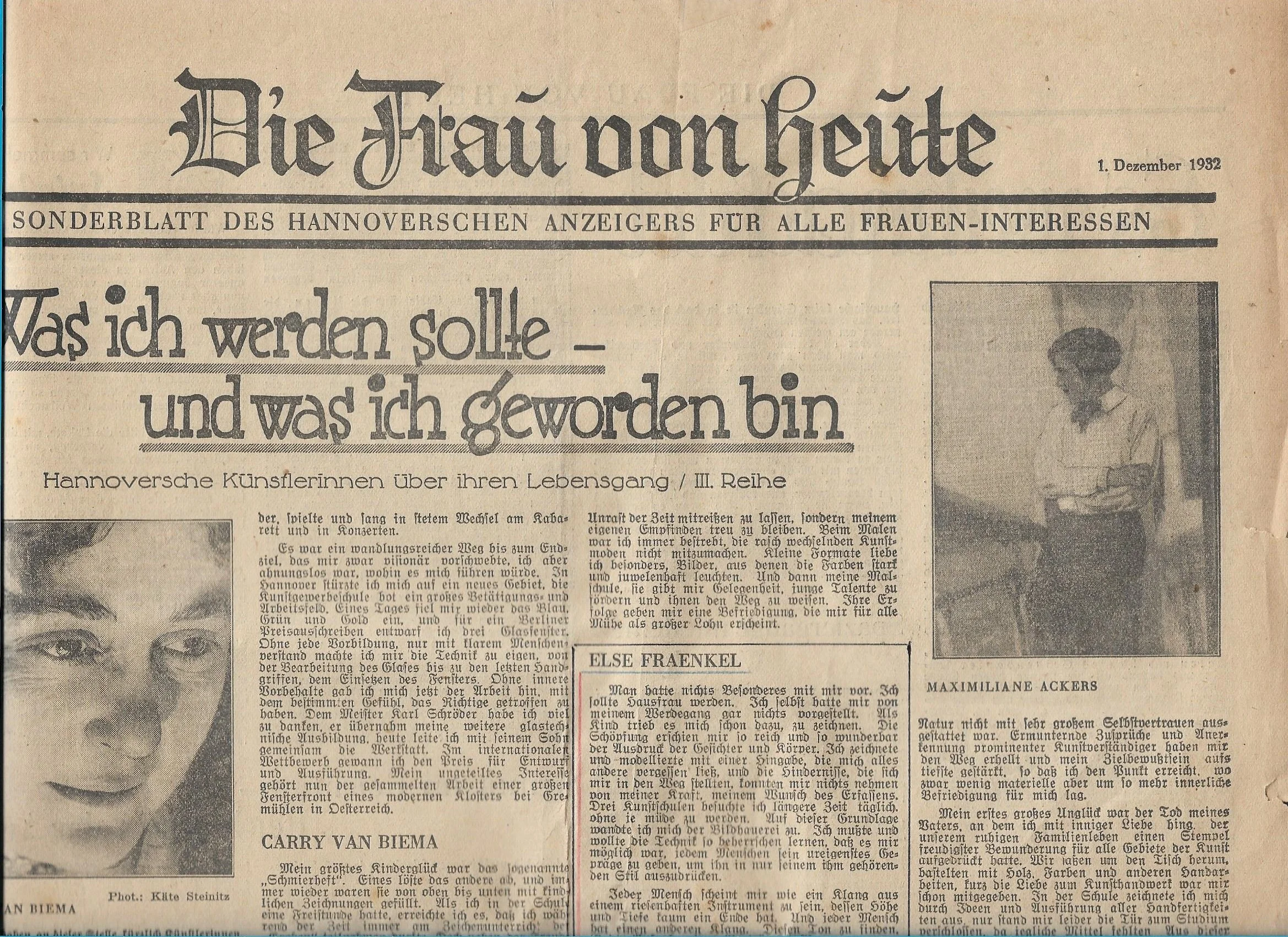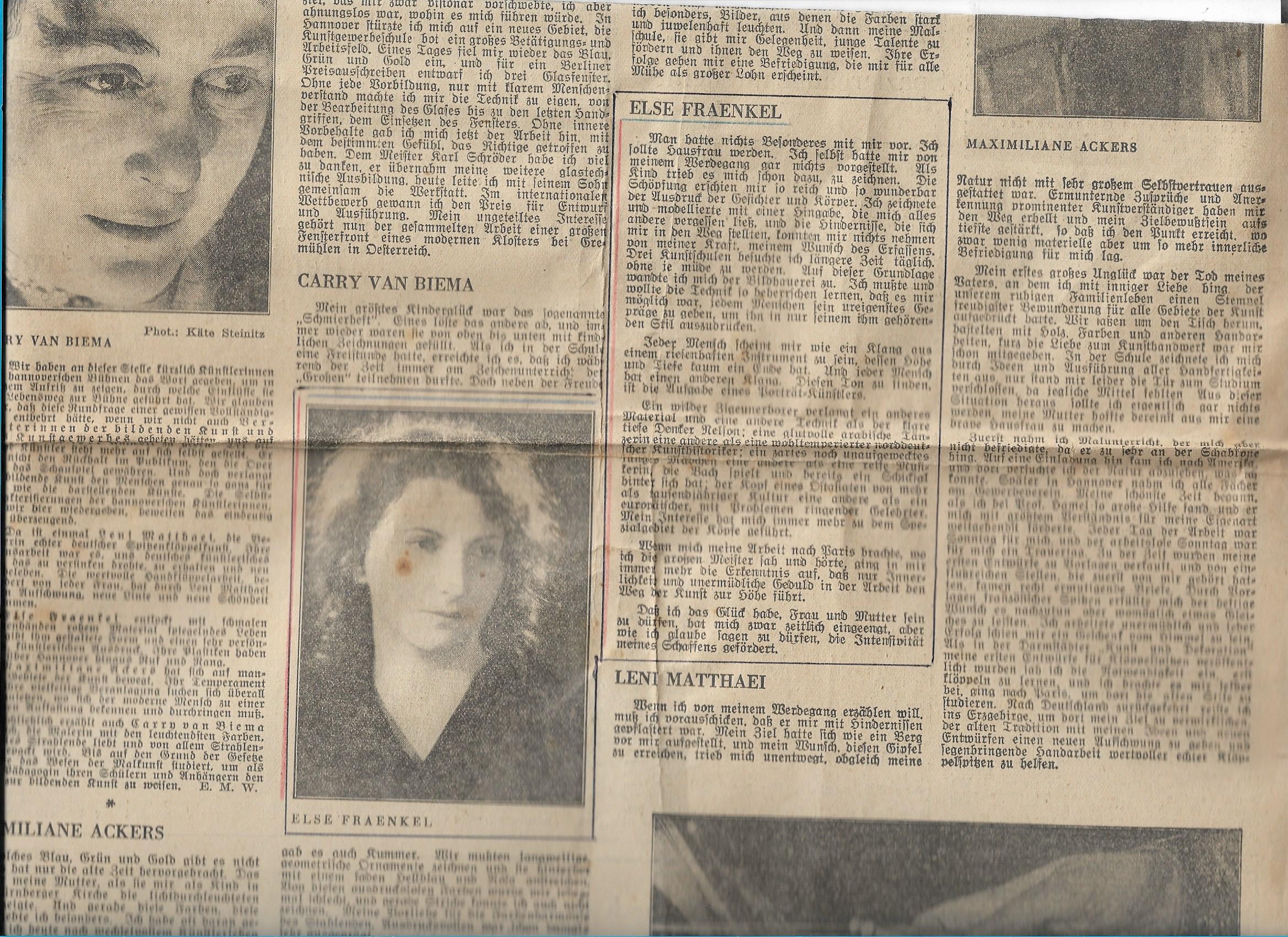Career
Elsa Fraenkel began to sculpt mainly bronze life size busts of family members and people she would come across in her daily life in Hanover, who struck her as being special in some way. None of these works were commissioned. She exhibited her works in Hanover, Berlin, Brunswick and Mannheim. Her sculpture of a young girl/bust of a girl was purchased in 1927 by the Landesmuseum, Hanover. In 1932, Elsa Fraenkel was interviewed by the local newspaper, Die Frau von Heute (pictured below) where she expressed how she works with her subjects (English translation here).
When Elsa Fraenkel and George Fraenkel lived in Hanover, they moved in intellectual and artistic social circles. Through these circles, Elsa made sculptures of the mathematician (Mueller, 1932), a philosopher (Professor Leopold Nelson, 1924), Musician (Musiker Kraal, 1927/29) and an art historian (Conrades, 1931). Through these circles, she also met family members and friends of intellectuals and artists. She met Mina Tobler (1927) based in Heidelberg, a Swiss pianist and mistress of famed sociologist Max Weber (he died in 1920). She met Madeleine, the granddaughter of the French poet Stéphane Mallarmé (1931). Between 1928 and 1930 through an aristocrat and industrialist Herbert von Garvens, Elsa also met the young Chinese (1928), Kadra the Arabian dancing girl (1929), and the Gypsy boxer (1930). The portrait of Kadra was in the Galerie von Garvens in Hannover, an art gallery opened by Herbert von Garvens in the 1920s.
Following her divorce, Elsa Fraenkel moved to Paris in 1933 and lived there till 1935. She was influenced by the portraits of Despiau and by the Chaldean art in the Louvre. In Paris, she worked with bronze and pewter. Among her works are portraits of professors she interacted with at the Sorbonne. Elsa Fraenkel began to feel that her future did not belong in France and having made some connections in England, she immigrated to London in 1935. Her son’s Jewish boarding school also relocated that year from Germany to England. She initially moved to Notting Hill Gate and later to St. John's Wood in London, England. In 1940 she moved to Loughton, Essex, where she lived in a flat at the now demolished The Elms, Church Lane. She was a member and officer of the Essex Art Club, and exhibited at its shows. Fortunately she carried at least one copy of many of her works with her from Germany to Paris and eventually to England as today there is very little evidence of Elsa Fraenkel’s works in German catalogues except for the foundry where her work were cast. Her sculpture of a young girl as well as the portrait of the young Chinese were located in the Sprengel Museum, Hanover in 2008.
Until the end of World War II, Fraenkel was less prolific but she continued to sculpt a few individuals she would meet. After the war however, many of Elsa’s works from Germany and Paris went on show in several London galleries and museums including the Leicester Galleries, Hove Museum, Ben Uri Gallery, Leighton House museum, Stafford Gallery, the Tate Gallery, and the Royal Academy. Her works have also been on show at the Tel Aviv Museum, the Jewish Museum in New York and the Royal Library in Copenhagen. In the 1950s, Fraenkel was a contemporary of Dora Gordine (also a sculptor) and became a friend of Sylvia Pankhurst. They worked on some joint projects together. Elsa Fraenkel organized , and personally mounted all the paintings by Sylvia for an exhibition in London. Elsa also began to receive commissions to sculpt bronze and silver busts of well known people from photographs.
Elsa Fraenkel moved to Bangalore, India to live with her daughter in 1970 and died there in 1975.
Memberships/Official Positions:
Fellow, Royal Society of Arts
Honorary Member of Council, The Royal Society for India, Pakistan and Ceylon
Vice President, Essex Art Club
Related online resources:
Profile of Elsa Fraenkel on the Ben Uri Research Unit website
2020 exhibition of “Gesellschaft der Freunde junger Kunst” collection (now owned by the Herzog Anton Ulrich Museum, Braunschweig) at Schlossmuseum Braunshweig (Braunschweig Castle Museum)
Copyright © 2019. Estate of Elsa Fraenkel. All Rights Reserved.

